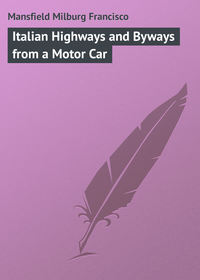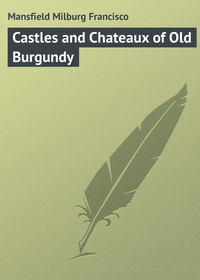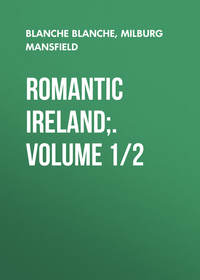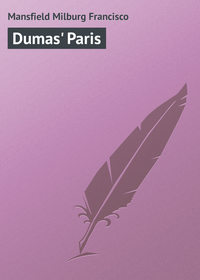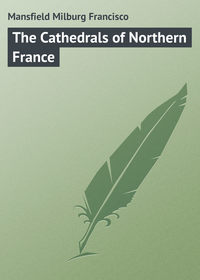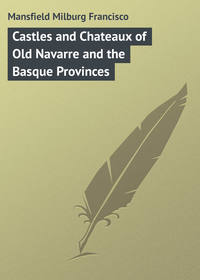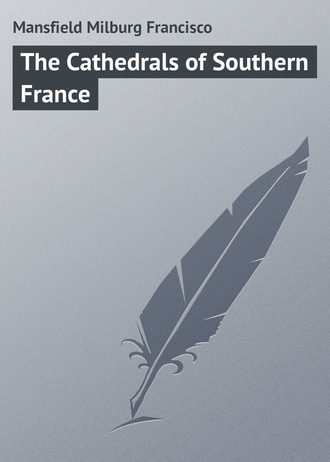 полная версия
полная версияThe Cathedrals of Southern France
To-day, as if doubtful of the shrine's efficacy, the pilgrims are few in number and mostly of the peasant class.
The bays of the nave are divided by round-headed arches, but connected with the opposing bay by the ogival variety.
The transepts have apsidal terminations, as is much more frequent south of the Loire than in the north of France, but still of sufficient novelty to be remarked here. The east end is rectangular – which is really a very unusual attribute in any part of France, only two examples elsewhere standing out prominently – the cathedrals at Laon and Dol-de-Bretagne. The cloister of Notre Dame, small and simple though it be, is of a singular charm and tranquillity.
With the tower or cupola of this cathedral the architects of Auvergne achieved a result very near the perfectionnement of its style. Like all of the old-time clochers erected in this province – anterior to Gothic – it presents a great analogy to Byzantine origin, though, in a way, not quite like it either. Still the effect of columns and pillars, in both the interior construction and exterior decoration of these fine towers, forms something which suggests, at least, a development of an ideal which bears little, or no, relation to the many varieties of campanile, beffroi, tour or clocher seen elsewhere in France. The spire, as we know it elsewhere, a dominant pyramidal termination, the love of which Mistral has said is the foundation of patriotism, is in this region almost entirely wanting; showing that the influence, from whatever it may have sprung, was no copy of anything which had gone before, nor even the suggestion of a tendency or influence toward the pointed Gothic, or northern style. Therefore the towers, like most other features of this style, are distinctly of the land of its environment – Auvergnian.
This will call to mind, to the American, the fact that Trinity Church in Boston is manifestly the most distinctive application, in foreign lands, of the form and features of the manner of church-building of the Auvergne.
Particularly is this to be noted by viewing the choir exterior with its inlaid or geometrically planned stonework: a feature which is Romanesque if we go back far enough, but which is distinctly Auvergnian in its mediæval use.
For sheer novelty, before even the towering bronze statue of the Virgin, which overtops the cathedral, must be placed that other needle-like basaltic eminence which is crowned by a tiny chapel dedicated to St. Michel.
This "aiguille," as it is locally known, rises something over two hundred and fifty feet from the river-bed at its base; like a sharp cone, dwindling from a diameter of perhaps five hundred feet at its base to a scant fifty at its apex.
St. Michel has always had a sort of vested proprietorship in such pinnacles as this, and this tiny chapel in his honour was the erection of a prelate of the diocese of Le Puy in the tenth century. The chapel is Romanesque, octagonal, and most curious; with its isolated situation, – only reached by a flight of many steps cut in the rock, – and its tesselated stone pavements, its mosaic in basalt of the portal, and its few curious sculptures in stone. As a place of pilgrimage for a twentieth-century tourist it is much more appealing than the Virgin-crowned rocher Corneille; each will anticipate no inconsiderable amount of physical labour, which, however, is the true pilgrim spirit.
The château of Polignac compels attention, and it is not so very foreign to church affairs after all; the house of the name gave to the court of Louis XIV. a cardinal.
To-day this one-time feudal stronghold is but a mere ruin. The Revolution finished it, as did that fury many another architectural glory of France.
XIV
NOTRE DAME DE CLERMONT-FERRAND
Clermont-Ferrand is the hub from which radiates in the season, – from April to October, – and in all directions, the genuine French touriste. He is a remarkable species of traveller, and he apportions to himself the best places in the char-à bancs and the most convenient seats at table d'hôte with a discrimination that is perfection. He is not much interested in cathedrals, or indeed in the twin city of Clermont-Ferrand itself, but rather his choice lies in favour of Mont Doré, Puy de Dôme, Royat, St. Nectaire, or a dozen other alluring tourist resorts in which the neighbouring volcanic region abounds.
By reason of this – except for its hotels and cafés – Clermont-Ferrand is justly entitled to rank as one of the most ancient and important centres of Christianity in France.
Its cathedral is not of the local manner of building: it is of manifest Norman example. But the Église Notre Dame du Port is Auvergnian of the most profound type, and withal, perhaps more appealing than the cathedral itself. Furthermore the impulse of the famous crusades first took form here under the fervent appeal of Urban II., who was in the city at the Council of the Church held in 1095. Altogether the part played by this city of mid-France in the affairs of the Christian faith was not only great, but most important and far-reaching in its effect.
In its cathedral are found to a very considerable extent those essentials to the realization of the pure Gothic style, which even Sir Christopher Wren confessed his inability to fully comprehend.
It is a pleasant relief, and a likewise pleasant reminder of the somewhat elaborate glories of the Isle of France, to come upon an edifice which at least presents a semblance to the symmetrical pointed Gothic of the north. The more so in that it is surrounded by Romanesque and local types which are peers among their class.
Truly enough it is that such churches as Notre Dame du Port, the cathedral at Le Puy, and the splendid series of Romanesque churches at Poitiers are as interesting and as worthy of study as the resplendent modern Gothic. On the other hand, the transition to the baseness of the Renaissance, – without the intervention of the pointed style, – while not so marked here as elsewhere, is yet even more painfully impressed upon one.
The contrast between the Romanesque style, which was manifestly a good style, and the Renaissance, which was palpably bad, suggests, as forcibly as any event of history, the change of temperament which came upon the people, from the fifteenth to the seventeenth centuries.
This cathedral is possessed of two fine western towers (340 feet in height), graceful in every proportion, hardy without being clumsy, symmetrical without weakness, and dwindling into crowning spires after a manner which approaches similar works at Bordeaux and Quimper. These examples are not of first rank, but, if not of masterful design, are at least acceptable exponents of the form they represent.
These towers, as well as the western portal, are, however, of a very late date. They are the work of Viollet-le-Duc in the latter half of the nineteenth century, and indicate – if nothing more – that, where a good model is used, a modern Gothic work may still betray the spirit of antiquity. This gifted architect was not so successful with the western towers of the abbey church of St. Ouen at Rouen. Externally the cathedral at Clermont-Ferrand shows a certain lack of uniformity.
Its main fabric, of a black volcanic stone, dates from 1248 to 1265. At this time the work was in charge of one Jean Deschamps.
The church was not, however, consecrated until nearly a century later, and until the completion of the west front remained always an unfinished work which received but scant consideration from lovers of church architecture.
The whole structure was sorely treated at the Revolution, was entirely stripped of its ornaments and what monuments it possessed, and was only saved from total destruction by a subterfuge advanced by a local magistrate, who suggested that the edifice might be put to other than its original use.
The first two bays of the nave are also of nineteenth-century construction. This must account for the frequent references of a former day to the general effect of incompleteness. To-day it is a coherent if not a perfect whole, though works of considerable magnitude are still under way.
The general effect of the interior is harmonious, though gloomy as to its lighting, and bare as to its walls.
The vault rises something over a hundred feet above the pavement, and the choir platform is considerably elevated. The aisles of the nave are doubled, and very wide.
The joints of pier and wall have been newly "pointed," giving an impression of a more modern work than the edifice really is.
The glass of the nave and choir is of a rare quality and unusually abundant. How it escaped the fury of the Revolution is a mystery.
There are two fifteenth-century rose windows in the transepts, and a more modern example in the west front, the latter being decidedly inferior to the others. The glass of the choir is the most beautiful of all, and is of the time of Louis IX., whose arms, quartered with those of Spain, are shown therein. The general effect of this coloured glass is not of the supreme excellence of that at Chartres, but the effect of mellowness, on first entering, is in every way more impressive than that of any other cathedral south of the Loire.
The organ buffet has, in this instance, been cut away to allow of the display of the modern rosace. This is a most thoughtful consideration of the attributes of a grand window; which is obviously that of giving a pleasing effect to an interior, rather than its inclusion in the exterior scheme of decoration.
In the choir is a retable of gilded and painted wood, representing the life of St. Crépinien, a few tombs, and in the chapels some frescoes of the thirteenth century. There is the much-appreciated astronomical clock – a curiosity of doubtful artistic work and symbolism – in one of the transepts.
A statue of Pope Urban II. is en face to the right of the cathedral.
At the Council of 1095 Urban II. preached for the first crusade to avenge the slaughter "of pilgrims, princes, and bishops," which had taken place at Romola in Palestine, and to regain possession of Jerusalem and the Holy Sepulchre from the Turkish Sultan, Ortock.
The enthusiasm of the pontiff was so great that the masses forthwith entered fully into the spirit of the act, the nobles tearing their red robes into shreds to form the badge of the crusader's cross, which was given to all who took the vow.
By command of the Pope, every serf who took the cross was to obtain his liberty from his overlord. This fact, perhaps, more than any other led to the swelled ranks of the first crusade under Peter the Hermit.
The rest is history, though really much of its written chronicle is really romance.
Clermont was a bishopric in the third century, with St. Austremoine as its first bishop. The diocese is to-day a suffragan of Bourges.
At the head of the Cours Sablon is a fifteenth-century fountain, executed to the order of a former bishop, Jacques d'Amboise.
The bibliothèque still preserves, among fifty thousand volumes and eleven hundred MSS., an illuminated folio Bible of the twelfth century, a missal which formerly belonged to Pope Clement VI., and a ninth-century manuscript of the monk, Gregory of Tours.
Near the cathedral in the Rue de Petit Gras is the birthplace of the precocious Blaise Pascal, who next to Urban II. – if not even before him – is perhaps Clermont's most famous personage. A bust of the celebrated writer is let into the wall which faces the Passage Vernines, and yet another adorns the entrance to the bibliothèque; and again another – a full-length figure this time – is set about with growing plants, in the Square Blaise Pascal. Altogether one will judge that Pascal is indeed the most notable figure in the secular history of the city. This most original intellect of his time died in 1662, at the early age of thirty-nine.
XV
ST. FULCRAN DE LODÈVE
Lodève, seated tightly among the mountains, near the confluence of the rivers Solondre and Lergue, not far from the Cevennes and the borders of the Gévaudan, was a bishopric, suffragan of Narbonne, as early as the beginning of the fourth century.
It had been the capital of the Gallic tribe of the Volsques, then a pagan Roman city, and finally was converted to Christianity in the year 323 by the apostle St. Flour, who founded the bishopric, which, with so many others, was suppressed at the Revolution.
The city suffered greatly from the wars of the Goths, the Albigenses, and later the civil wars of the Protestants and Catholics. The bishops of Lodève were lords by virtue of the fact that the title was bought from the viscounts whose honour it had previously held. St. Guillem Ley Desert (O. F.), a famous abbey of the Benedictines, founded by an ancestor of the Prince of Orange, is near by.
The ancient cathedral of St. Fulcran is situated in the haute-ville and dates, as to its foundation walls, from the middle of the tenth century. The reconstructed present-day edifice is mainly of the thirteenth century, and as an extensive work of its time is entitled to rank with many of the cathedral churches which survived the Revolution. By the end of the sixteenth century, the last remaining work and alterations were completed, and one sees therefore a fairly consistent mediæval church. The west façade is surmounted by tourelles which are capped with a defending mâchicoulis, presumably for defence from attack from the west, as this battlement could hardly have been intended for mere ornament, decorative though it really is. The interior height rises to something approximating eighty feet, and is imposing to a far greater degree than many more magnificent and wealthy churches.
The choir is truly elegant in its proportions and decorations, its chief ornament being that of the high-altar, and the white marble lions which flank the stalls. From the choir one enters the ruined cloister of the fifteenth century; which, if not remarkable in any way, is at least distinctive and a sufficiently uncommon appendage of a cathedral church to be remarked.
A marble tomb of a former bishop, – Plantavit de la Pause, – a distinguished prelate and bibliophile, is also in the choir. This monument is a most worthy artistic effort, and shows two lions lying at the foot of a full-length figure of the churchman. It dates from 1651, and, though of Renaissance workmanship, its design and sculpture – like most monumental work of its era – are far ahead of the quality of craftsmanship displayed by the builders and architects of the same period.
The one-time episcopal residence is now occupied by the hôtel de ville, the tribunal, and the caserne de gendarmerie. As a shelter for civic dignity this is perhaps not a descent from its former glory, but as a caserne it is a shameful debasement; not, however, as mean as the level to which the papal palace at Avignon has fallen.
The guide-book information – which, be it said, is not disputed or reviled here – states that the city's manufactories supply surtout des draps for the army; but the church-lover will get little sustenance for his refined appetite from this kernel of matter-of-fact information.
Lodève is, however, a charming provincial town, with two ancient bridges crossing its rivers, a ruined château, Montbrun, and a fine promenade which overlooks the river valleys round about.
PART III
The Rhône Valley
I
INTRODUCTORY
The knowledge of the geographer Ptolemy, who wrote in the second century with regard to the Rhône, was not so greatly at fault as with respect to other topographical features, such as coasts and boundaries.
Perhaps the fact that Gaul had for so long been under Roman dominion had somewhat to do with this.
He gives, therefore, a tolerably correct account as to this mighty river, placing its sources in the Alps, and tracing its flow through the lake Lemannus (Leman) to Lugdunum (Lyon); whence, turning sharply to the southward, it enters the Mediterranean south of Arles. Likewise, he correctly adds that the upper river is joined with the combined flow of the Doubs and Saône, but commits the error of describing their source to be also in the Alps.
Philip Gilbert Hamerton, who knew these parts well, – his home was near Autun, – has described the confluence of the Saône and Rhône thus:
"The width and depth of the two rivers are equal, but the swift-flowing Rhône discharges twice the volume of water of the slow-running Saône. They also differ remarkably in colour. The Saône is emerald-green and the Rhône blue-green. Here the minor river loses its name and character, and, by an unusual process, the slowest and most navigable stream in Europe joins the swiftest and least navigable. The Flumen Araris ceases and becomes the Rhodanus."
The volume of water which yearly courses down the Rhône is perhaps greater than would first appear, when, at certain seasons of the year, one sees a somewhat thin film of water gliding over a wide expanse of yellow sand and shingle.
Throughout, however, it is of generous width and at times rises in a true torrential manner: this when the spring freshets and melting Alpine snows are directed thither toward their natural outlet to the sea. "Rivers," said Blaise Pascal, "are the roads that move." Along the great river valleys of the Rhône, the Loire, the Seine, and the Rhine were made the first Roman roads, the prototypes of the present-day means of communication.
The development of civilization and the arts along these great pathways was rapid and extensive. Two of them, at least, gave birth to architectural styles quite differing from other neighbouring types: the Romain-Germanique– bordering along the Rhine and extending to Alsace and the Vosges; and the Romain-Bourguignon, which followed the valley of the Rhône from Bourgogne to the Mediterranean and the Italian frontier, including all Provence.
The true source of the Rhône is in the Pennine Alps, where, in consort with three other streams, the Aar, the Reuss, and the Ticino, it rises in a cloven valley close to the lake of Brienz, amid that huge jumble of mountain-tops, which differs so greatly from the popular conception of a mountain range.
Dauphiné and Savoie are to-day comparatively unknown by parlour-car travellers. Dauphiné, with its great historical associations, the wealth and beauty of its architecture, the magnificence of its scenery, has always had great attractions for the historian, the archæologist, and the scholar; to the tourist, however, even to the French tourist, it remained for many years a terra incognita. Yet no country could present the traveller with a more wonderful succession of ever-changing scenery, such a rich variety of landscape, ranging from verdant plain to mountain glacier, from the gay and picturesque to the sublime and terrible. Planted in the very heart of the French Alps, rising terrace above terrace from the lowlands of the Rhône to the most stupendous heights, Dauphiné may with reason claim to be the worthy rival of Switzerland.
The romantic associations of "La Grande Chartreuse"; of the charming valley towns of Sion and Aoste, famed alike in the history of Church and State; and of the more splendidly appointed cities of Grenoble and Chambéry, will make a new leaf in the books of most peoples' experiences.
The rivers Durance, Isère, and Drôme drain the region into the more ample basin of the Rhône, and the first of the three – for sheer beauty and romantic picturesqueness – will perhaps rank first in all the world.
The chief associations of the Rhône valley with the Church are centred around Lyon, Vienne, Avignon, and Arles. The associations of history – a splendid and a varied past – stand foremost at Orange, Nîmes, Aix, and Marseilles. It is not possible to deal here with the many pays et pagi of the basin of the Rhône.
Of all, Provence – that golden land – stands foremost and compels attention. One might praise it ad infinitum in all its splendid attributes and its glorious past, but one could not then do it justice; better far that one should sum it up in two words – "Mistral's world."
The popes and the troubadours combined to cast a glamour over the "fair land of Provence" which is irresistible. Here were architectural monuments, arches, bridges, aqueducts, and arenas as great and as splendid as the world has ever known. Aix-en-Provence, in King René's time, was the gayest capital of Europe, and the influence of its arts and literature spread to all parts.
To the south came first the Visigoths, then the conflicting and repelling Ostrogoths; between them soon to supplant the Gallo-Roman cultivation which had here grown so vigorously.
It was as late as the sixth century when the Ostrogoths held the brilliant sunlit city of Arles; when follows a history – applicable as well to most of all southern France – of many dreary centuries of discordant races, of varying religious faiths, and adherence now to one lord and master, and then to another.
Monuments of various eras remain; so numerously that one can rebuild for themselves much that has disappeared for ever: palaces as at Avignon, castles as at Tarascon and Beaucaire, and walled cities as at Aigues-Morte. What limitless suggestion is in the thought of the assembled throngs who peopled the tiers of the arenas and theatres of Arles and Nîmes in days gone by. The sensation is mostly to be derived, however, from thought and conjecture. The painful and nullifying "spectacles" and "courses des taureaux," which periodically hold forth to-day in these noble arenas, are mere travesties on their splendid functions of the past. Much more satisfying – and withal more artistic – are the theatrical representations in that magnificent outdoor theatre at Orange; where so recently as the autumn of 1903 was given a grand representation of dramatic art, with Madame Bernhardt, Coquelin, and others of the galaxy which grace the French stage to-day, taking part therein.
Provençal literature is a vast and varied subject, and the women of Arles – the true Arlesians of the poet and romancer – are astonishingly beautiful. Each of these subjects – to do them justice – would require much ink and paper. Daudet, in "Tartarin," has these opening words, as if no others were necessary in order to lead the way into a new world: "It was September and it was Provence." Frederic Mistral, in "Mirèio," has written the great modern epic of Provence, which depicts the life as well as the literature of the ancient troubadours. The "Fountain of Vaucluse" will carry one back still further in the ancient Provençal atmosphere; to the days of Petrarch and Laura, and the "little fish of Sorgues."
What the Romance language really was, authorities – if they be authorities – differ. Hence it were perhaps well that no attempt should be made here to define what others have failed to place, beyond this observation, which is gathered from a source now lost to recollection, but dating from a century ago at least:
"The southern or Romance language, the tongue of all the people who obeyed Charlemagne in the south of Europe, proceeded from the parent-vitiated Latin.
"The Provençaux assert, and the Spaniards deny, that the Spanish tongue is derived from the original Romance, though neither the Italians nor the French are willing to owe much to it as a parent, in spite of the fact that Petrarch eulogized it, and the troubadours as well.
"The Toulousans roundly assert that the Provençal is the root of all other dialects whatever (vide Cazeneuve). Most Spanish writers on the other hand insist that the Provençal is derived from the Spanish (vide Coleccion de Poesias Castellanas; Madrid, 1779)."
At all events the idiom, from whatever it may have sprung, took root, propagated and flourished in the land of the Provençal troubadours.
Whatever may have been the real extent of the influences which went out from Provence, it is certain that the marriage of Robert with Constance – daughter of the first Count of Provence, about the year 1000 – was the period of a great change in manners and customs throughout the kingdom. Some even have asserted that this princess brought in her train the troubadours who spread the taste for poetry and its accompaniments throughout the north of France.




